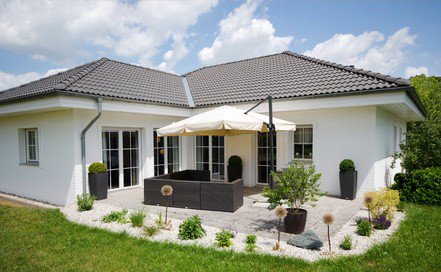You have taken the exciting step of “building a house”: you have bought a plot of land , your own bungalow-style home already selected and commissioned a construction company. Breathe! The biggest effort is behind you, you think… But far from it! Every day there are new decisions in the house that has not yet been built, all of which would rather be made today than tomorrow. When it comes to heating, in particular, opinions differ in terms of effectiveness, economy, environmental compatibility and price development. Heat pump or gas heating? I would like to heat with wood, is a pellet heating system or a wood chip heating system more suitable? What about the fuel cell? Environmentally friendly heating with solar thermal energy? This article provides an overview of possible heat suppliers for new buildings in the detached house segment and provides you with information that will make it easier for you to choose the right heating system for you. This makes the market considerably more transparent for you.
the essentials in brief
- Oil heating, gas heating, wood heating, heat pump, electric heating, infrared heating, combined heat and power plant, fuel cell, solar thermal energy: The choice of the system needs to be well thought out, since a large part of your energy requirement is due to heat generation.
- The various heaters differ primarily in the following points: acquisition and operating costs, sustainability of resources, associated funding programs and installation requirements.
- Get detailed advice on the type of heating and manufacturer and make sure that you have a contact person for installation and maintenance in your area.
Heaters: The source of heat

First of all, you should think about your desired energy source, because heating can be done with oil, gas, electricity as well as with their regenerative competitors such as wood, geothermal or air heat and solar energy . What many people don’t know is that Germans use more than half of their energy to generate heat. So there is a lot of unused savings potential here, which can quickly make itself felt in your wallet. In this context, looking to the future should also play an important role in your decision. The so-called Energy Saving Ordinance (EnEV) gradually lowers the permitted primary energy requirement of a new building. If you want to secure an appropriate resale value for your house, a corresponding calculation of your energy requirements is of great importance. It is also worth considering regenerative heating systems with regard to state subsidies that are awarded to support energy-efficient houses. In the following we have summarized the advantages and disadvantages of the different types of heating for you.
oil heating
- Acquisition costs : 6.000 – 8.0000€ (10.000 – 16.000€ in combination with renewable energies)
- Sustainability : Use of fossil raw materials, high CO2 emissions
- Funding: KfW programs for energy-efficient renovation and modernization (not for new buildings)
- Advantages : mature technology, independence from existing infrastructure, low heating costs
- Disadvantages : more space required by the oil tank, dependence on fluctuating oil prices, finite nature of fossil fuels, for new builds only in combination with renewable energies (heat pump, solar thermal energy – depending on the respective primary energy requirement and transmission heat loss of the house)
gas heating
- Acquisition costs: €5,000 – €7,000 (€10,000 – €13,000 in combination with renewable energies)
- Sustainability: Use of fossil raw materials, but lower CO2 emissions compared to oil
- Funding: KfW programs for energy-efficient renovation and modernization, possibly additional funding from local energy suppliers
- Advantages: Comparatively cheap purchase and low consumption thanks to sophisticated technology
- Disadvantages: Gas connection or gas tank required, dependence on gas supplies
Wood heating (pellet, wood chips, logs)
- Acquisition costs: €18,000 to €25,000
- Sustainability: renewable fuel, CO2 emissions available
- Funding: KfW programs, BAFA funding for selected wood heating systems in existing buildings
- Advantages: Independence from energy suppliers, constant prices, large variety of models
- Disadvantages: storage requires a lot of space, relatively high initial costs

heat pump
- Acquisition costs: from €12,000 (depending on the heat pump type)
- Sustainability: no emissions on site (depending on the type of power generation)
- Funding: numerous!, KfW programs, BAFA funding for selected pumps, funding programs from local suppliers
- Advantages: environmentally friendly (especially with photovoltaics), no storage necessary, in combination with a photovoltaic system certain independence from the electricity price, as own electricity generation
- Disadvantages: Location and property conditions can affect profitability
electric heating
- Acquisition costs: €5,000 – €8,000
- Sustainability: currently high CO2 emissions (depending on power generation)
- Funding: none
- Advantages: low investment costs, easy to control, small space requirement
- Disadvantages: high operating costs, rising electricity prices, questionable future use
infrared heating
- Acquisition costs: €5,000 – €8,000
- Sustainability: currently high CO2 emissions (depending on power generation)
- Funding: none
- Advantages: low investment costs, space-saving, high efficiency, short preheating times
- Disadvantages: high operating costs, rising electricity prices, requires a good standard of insulation in the house
combined heat and power plant
- Acquisition costs: €20,000 – €40,000
- Sustainability: depending on the raw material supplier (natural, bio, or liquid gas, heating oil, wood)
- Funding: KfW program for energy-efficient renovation and modernization, BAFA program, subsidy for self-consumed electricity possible in advance
- Advantages: combined electricity and heat generation, self-supply with electricity possible, independence from energy suppliers, small space requirement
- Disadvantages: high acquisition and maintenance costs, low economic efficiency with low energy requirements, dependence on fossil fuels (if no wood or biogas is used)
fuel cell
- Acquisition costs: €30,000 – €50,000
- Sustainability: low CO2 emissions
- Funding: many programs, including the KfW program and BAFA funding, flat-rate payment for self-generated electricity
- Advantages: Highly efficient generation of electricity and heat, space-saving system, low energy costs, independence from the development of electricity prices, high government subsidies, climate-friendly
- Disadvantages: Dependence on gas and its price development, high acquisition costs, regular maintenance costs, requires high energy requirements so that the system does not generate an unnecessary surplus
solar thermal
- Acquisition costs: 5,000 to 14,000 € (depends on whether only hot water preparation or heating support)
- Sustainability: almost CO2-neutral, regenerative energy source
- Funding: KfW and BAFA funding
- Advantages: independence from energy suppliers, unlimited energy source, long service life
- Disadvantages: usually does not cover the entire energy requirement (combination with other heating sources necessary), is not suitable for every location (pay attention to shading and incidence of light), some components have to be disposed of separately

Electric and infrared heating are conceivable as a temporary or additional solution for heating individual rooms, since the high operating costs are not economical in the long term. Added to this are the rising electricity prices and the poor ecological balance, which make the future prospects for electric heating – also from a political point of view – appear rather bleak. Oil and gas heating systems now come with sophisticated technology and have long ceased to be uncontrolled CO2 emitters. However, the dependency on fossil raw materials remains. Since the finite nature of the world’s oil reserves is not in the too distant future, oil heating systems for new buildings are only extremely rarely offered. Here, too, the question must be asked as to how long their use will be legally permitted. Solar collectors and heat pumps, on the other hand, impress with their environmentally friendly and energy-efficient mode of operation. Although they are significantly more expensive to purchase, they are also supported with numerous funding programs. Wood heaters are a good choice here and can be easily combined with solar and heat pump technology.
Combined heat and power plants and fuel cells as systems that generate heat and electricity hold a promise of salvation for environmentally friendly energy production that has not yet been able to be used on a large scale. On the one hand, this is due to the high acquisition costs and, on the other hand, a high energy requirement is required for the purchase to pay off. So far, the use in the construction of one- and two-family houses is still manageable.
Warmly recommended: select the system and manufacturer with good advice and thorough information
Have you decided which heater should keep you warm in winter? Now there is the next dilemma: Should it be a heater from Junkers, Viessmann, Wolf or Vaillant? Online research brings to light not only praise but also a lot of criticism for all these manufacturers. Without exception, all of them are very large companies that successfully sell their products internationally. At Stiftung Warentest, one gas boiler and another oil condensing boiler performed better. So on what basis to choose?

Take the time for a detailed consultation, because after all, your heating system should accompany you for most of your domestic life. Make sure you have a local contact you can contact if you have any problems. In addition, an agreement with your construction company, should they be responsible for the installation, is absolutely necessary. Benefit from testimonials, but still trust your own research. Be creative when it comes to combining different systems. With a satisfied look at your annual energy bill, the effort will have been worth it.



